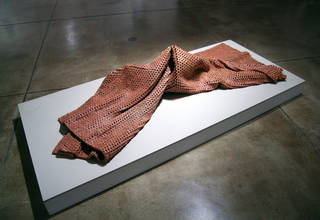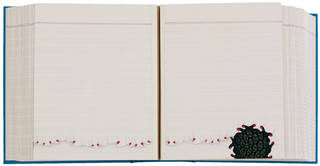The Jameel Prize is an international award for contemporary art and design inspired by Islamic tradition. Its aim is to explore the relationship between Islamic traditions of art, craft and design and contemporary work as part of a wider debate about Islamic culture and its role today.
RACHID KORAÏCHI – WINNER OF THE JAMEEL PRIZE 2011

Algerian born Rachid Koraïchi was announced as the winner of the Jameel Prize 2011 for a selection of embroidered cloth banners from a series entitled Les Maitres invisibles (The Invisible Masters), 2008.
Koraichi uses Arabic calligraphy, and symbols and ciphers from a range of other languages and cultures to explore the lives and legacies of the 14 great mystics of Islam. The work aims to show that the world of Islam, in contrast to contemporary perceptions of crisis and violence, has another side entirely. Koraïchi cites great Muslim thinkers and poets like Rumi and El Arabi to show the sophistication and tolerance of Islamic ideology and how relevant it is today. These 'masters', whose fame has spread even to the West, have left an imprint on successive generations and their message is just as relevant today as when first written down.
He has consistently attempted to reconcile Islamic tradition and mysticism with the aim to revive and re-invent his countries' artistic legacy. Koraïchi puts huge value upon the craftsmen he works with as the keepers and messengers of the ‘know how’. His work is a tribute to his ancestors' spirituality, craftsmanship and journey through history and his work draws on numerology and signs.
The Judges felt that Rachid's work matches the aims of the Jameel Prize through its qualities of design and reliance on traditional craft. They particularly admired how he has made his great spiritual and intellectual lineage accessible to all through the graphic language he has created out of his artistic heritage.
Rachid's work stood out because his banners have a universal appeal. They work in the white space of a contemporary art gallery, but they also hold their own in historical settings – from Parisian palaces to simple Sufi shrines.
THE JUDGES
Professor Martin Roth, Director of the V&A
Wassan Al-Khudhairi, Director, Mathaf: Arab Museum of Modern Art, Qatar
Navid Akhtar, Executive Director, Gazelle Media
Afruz Amighi, artist
Dina Bakhoum, Conservation Programme Manager, The Aga Khan Trust for Culture, Egypt
THE SHORTLISTED ARTISTS AND DESIGNERS
Noor Ali Chagani

Noor Ali Chagani was shortlisted for his two works Lifeline (2010) and Infinity (2009) – sculptural works made from miniature terracotta bricks. Chagani translates his training in the principles of Mughal miniature painting into sculpture by using miniature hand made bricks to imitate large building blocks. Both works refer to the fundamental desires of man to provide a house for shelter.
The curves and movements of the bricks in Lifeline are like a piece of cloth, serving as protection, shelter and wrapping, just as clothes provide a second skin. However, made of brittle and hard bricks, they define the toughness and hardships of life's daily struggle.
Infinity continues Chagani's interest with bricks by creating the illusion of an endless series of walls, each made from hundreds of handmade bricks. The work reflects a view of history, the broken walls and homes of an ancient civilization and the endless hurdles and obstacles faced by man.
Noor Ali Chagani (b. 1982, Karachi, Pakistan) lives and works in Lahore, Pakistan. He completed a BFA at the National College of Arts, Lahore in 2008, specialising in Mughal, Persian and Indian miniature painting.
Monir Shahroudy Farmanfarmaian

Monir Shahroudy Farmanfarmaian is one of Iran's most celebrated artists with a career spanning more than five decades. Birds of Paradise (2008), is a work that demonstrates her distinctive style of adapting and combining Iranian traditions of mirror mosaic and reverse glass painting techniques with a modern aesthetic. Mirrors are cut and set in geometric patterns and integrated with coloured glass, referencing a range of influences in Islamic art, architecture and science. This particular work is inspired by the many feathers left by sparrows on her balcony in Tehran.
Farmanfarmaian spent nearly a decade living in New York during the 1940s and 1950s as an art student and later as a fashion illustrator where she worked alongside Andy Warhol. She returned to Iran in the 1960s where she held major exhibitions in Tehran, Paris, Venice and New York.
Farmanfarmaian currently lives and works in Tehran.
Bita Ghezelayagh

Bita Ghezelayagh works in the traditional Iranian craft of felt-making. Her work consisted of three pieces from her Felt Memories series (2008-9).
Ghezelayagh is inspired by the Islamic tradition of talismanic garments worn to protect the wearer from misfortune in battle. She reinvents this tradition, which would originally have used luxurious materials, by substituting them with everyday rural material such as felt.
Heavily influenced by post revolutionary popular culture, Ghezelayagh uses metal keys, crowns, tulips (symbols of martyrdom), machine guns and other street symbols combined with printed Persian phrases to cover the surface of her pieces. The juxtaposition of urban imagery with a rural craft tradition creates a new visual language which embraces both tradition and modernity.
Ghezelayagh was born in Italy and now lives and works between London and Tehran.
Babak Golkar

Babak Golkar's piece entitled Negotiating the Space for Possible Coexistencies No.5 (2011) is an example of Golkar's multi-disciplinary work, examining socio-cultural issues experienced from living in both the Middle East and Canada.
This work is part of a series that uses the pattern of Persian carpets as a blue print for architectural scale models. The model sits on top of the carpet so that the relationship between the two forms is accessible to the viewer, creating a conceptual connection between the traditions of Modern and Post-Modern architecture and the traditions of the nomadic society. The work also challenges the spatial economies of the two traditions offering a space for cross-cultural dialogue.
Golkar uses the icon of the Persian carpet to re-examine his own connection to his Iranian heritage and North American context. He creates bodies of work which attempt to negotiate the space between these cultures. More specifically, his work manoeuvres between seemingly opposing realms such as East and West, modernity and antiquity, minimalism and ornament.
Golkar was born in the USA and now lives and works in Canada.
Aisha Khalid – People's Choice winner

Aisha Khalid's two entries are Kashmiri Shawl and Name, Class, Subject (2009). Kashmiri Shawl is a cashmere cloth pierced with 300,000 gold-plated pins which create a traditional paisley pattern. For Khalid, the sharp pins symbolise the agony of the people in occupied Kashmir.
Name, Class, Subject is an artists book inspired by the exercise or 'copy books' used by government schools in Pakistan to teach writing in Urdu and English. Khalid's inspiration for her work is based directly on her classical training as a miniature painter and draws on her experience as a child growing up in a society shaped by a bilingual culture. Khalid has painted each of the 280 pages of the book in the Mughal style of miniature painting, to look like a ruled exercise book.
There are 'errors' in the Urdu pages, reminders of the mistakes Khalid used to find in her printed text books in Pakistan, such as missing text and lines or badly cut margins. In the middle of the book, both English and Urdu page lines are blurred and overlapping, referencing the tensions underlying Pakistan's past and present. The lined pages invite readers to imagine their suggested narrative and encourages them to write their own text between the lines.
Hayv Kahraman

Hayv Kahraman's two paintings are from her Waraq series (Playing Cards), Migrant 1 and Migrant 8 (2010), and her new work Asad Babil (2011) inspired by her experience of living in Baghdad, Europe and the USA.
Waraq means 'paper cards' in Arabic and references a popular Iraqi pastime. Kahraman has invented a suit of cards to explore the lives of people who personify the Iraqi Diaspora and their stories of assimilation, alienation and discovery in their new homes.
The work also references so called 'Archaeology awareness playing cards' – 40,000 decks of cards which were sent to American troops in Iraq and Afghanistan in 2007 to highlight important archaeological sites and to discourage illegal trade in artefacts.
Asad Babil depicts an injured life-sized lion painted in Islamic geometric patterns and black and red paint. A set of 'diasporic' playing cards gushes from the lions' mouth, instead of blood, referencing the fall of Iraq and the wounded people as its victims and prey.
Kahraman was born in Iraq and now lives and works in the USA.
Hazem El Mestikawy

Hazem El Mestikawy exhibited a sculptural installation made from recycled cardboard and newspaper entitled Bridge (2009).
The work is a continuation of his exploration of the socio-political issues of North versus South and East versus West. El Mestikawy defines the space between different regions, both geographically and metaphorically. The building and pattern of the work depend on the equity of all the edges; there are no stronger and no weaker edges, the parts are equal and occupy an equal amount of space. His practice assimilates ancient Eygptian and Islamic art and architecture, as well as contemporary and minimal art philosophies.
El Mestikawy was born in Egypt and lives and works in between Egypt and Austria.
Hadieh Shafie

Hadieh Shafie's two new works, 22500 (2011) and 26000 (2011) are a continuation of her signature paper scroll works. In Shafies work, the notion of meditative process, repetition and time as found in Islamic art, craft and architecture is a constant element.
Made up of 22,500 and 26,000 strips of paper, each scroll is marked with printed and hand written Farsi (Persian) text then tightly rolled into concentric circles, concealing or revealing different elements of the text. The concentric forms of both text and material take their inspiration from the dance of the whirling dervish. Shafie's paper scroll works demonstrate a constant element of her work: the significance of process, repetition and time, all rooted in the influence of Islamic art and craft. She seeks to create work which is rich in layers of meaning and gives the viewer an opportunity for contemplation and reflection.
Shafie was born in Iran and lives and works in the USA.
Soody Sharifi

Soody Sharifi's entry featured two prints – Frolicking Women (2007) and Fashion Week (2010).
Sharifi creates digital collages using enlarged scans of original Persian miniatures in which inserts her own photographic images, creating what she calls 'Maxiatures'. Sharifi's digital collages explore tension between public and private spaces.
Her subject matter ranges from Islam and the clash of cultures, to modernity and youth culture. She seeks to demystify contemporary life in Iran by opening up scenes of private life and blurring the line between reality and fiction as well as reflecting on the dialogue between East and West.
By using the miniature format and combining original imagery with contemporary life, she provides a continuity from past to present. Meticulously inserting contemporary details into historical fiction she creates her own personal narrative.
Frolicking Women was inspired by several trips Sharifi made to Iran's coasts, from photographs she took of the public beaches of Kish and the Caspian sea where men and children, unlike women, could freely swim with their bathing suits. She parallels the photographs of clothed women swimming alongside the 14th-century Iranian depiction of nude women bathing.
Soodi Sharifi was born in Iran and lives and works in the USA.
